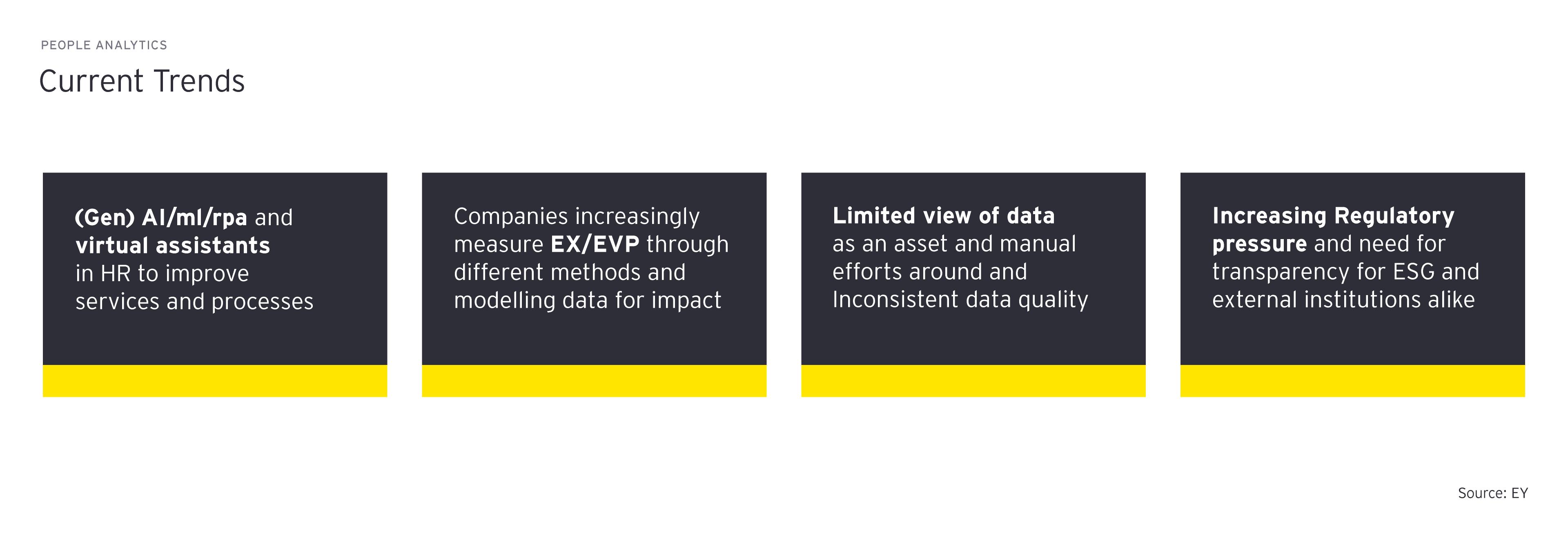Leveraging workforce insights
Unlocking the potential of People Analytics is a game-changer for organizations striving to thrive in the modern business landscape. By harnessing the power of data-driven insights, businesses can gain a competitive edge in various crucial aspects. Below we provide some examples of how workforce data can be leveraged:
Anticipating future skills and talent needs: A predictive analysis allows organizations to forecast their future talent needs. By examining historical data, HR teams can make informed decisions and predictions about recruitment, succession planning and workforce development. This proactive approach reduces hiring costs and ensures a skilled and adaptable workforce. By adding external data, e.g., regional job market data, a broader analysis can shed light on the health status of the talent pipeline.
Enhancing employee engagement and retention: Through data analysis as well as active and passive listening, organizations can measure and improve employee engagement and retention. By identifying the drivers of employee satisfaction, such as leadership styles and workplace conditions, companies can tailor their strategies to reduce undesired employee turnover and foster a more productive workforce.
Fine-tuning leadership skills and training initiatives: People Analytics provides insights into leadership effectiveness and training needs. By analyzing performance data and employee feedback through active and passive listening, organizations can pinpoint areas requiring leadership development and targeted training programs. This investment leads to improved management practices, driving enhanced employee performance and overall organizational success.
Understanding workforce performance: Operational HR analytics provides granular insights into employee performance. By tracking key performance indicators (KPIs) and aligning them with organizational goals, HR professionals can identify high-performing individuals, recognize areas for improvement as well as provide targeted training and development opportunities. This data-driven approach not only enhances employee productivity but also contributes to achieving broader business objectives.
These insights translate into cost savings, higher job satisfaction and improved organizational performance — a powerful formula for long-term success.
Leveraging operational HR insights
For companies committed to efficient HR management, it is a strategic imperative to incorporate components such as process analysis, optimized resource allocation and budgeting as well as accurate performance tracking into their daily operations. Below we provide some examples of how operational HR skills can be leveraged:
Optimizing HR workflows: Process mining enables HR departments to visualize, analyze and optimize their workflows. By mapping out the entire employee lifecycle from hire to retire, organizations can identify bottlenecks, streamline processes and reduce administrative burdens. This leads to faster onboarding, improved compliance and enhanced overall operational efficiency.
Allocating resources strategically: Operational HR analytics empowers organizations to strategically allocate their resources. HR teams can optimize workforce planning, identify skills gaps and allocate budgets where they will have the most impact. A proactive approach ensures that resources are utilized efficiently and that the organization remains agile in responding to ever-changing demands from the business.
Cost-benefit analysis of HR initiatives: Operational data allows HR to perform cost-benefit analyses on its various initiatives, whether it is a new recruitment campaign, training programs or a workplace technology initiative, to ensure that any investment made contributes efficiently to the wider organizations bottom line.
Embracing operational HR analytics empowers organizations to achieve greater efficiency in human resource management and to ensure that the department maximizes its potential within the financial budget.
Challenges in harnessing operational HR and workforce data
Unlocking people data’s value within organizations can be challenging. Legacy systems, outdated and incompatible with modern tools, create hurdles for data analysis. Inconsistent practices across units result in data silos and conflicts over ownership. To conquer these challenges and reveal data’s potential, leaders should establish robust data governance in the people data domain. Standardization ensures data consistency, while data security safeguards against expensive breaches.
Data governance serves as a guiding compass, navigating organizations through the complexities of data management and positioning them for success.
Data quality as an imperative
Ensuring data quality is critical to the future success of any organization. Poor data quality can have significant consequences by affecting decision-making, employee satisfaction, legal compliance and resource allocation. Inaccurate or incomplete data can lead to misguided hiring decisions, legal complications and inefficiencies in HR processes.
This especially applies when artificial intelligence (AI) and advanced analytics are introduced into HR processes, making data quality even more important. AI systems rely on historical data to make predictions and recommendations, but if this data is tainted with biases or inaccuracies, issues are likely to be perpetuated. It may lead to biased hiring recommendations, inefficient automation, ineffective predictions and potential damage to the organization’s reputation due to wrongful legal reporting.



